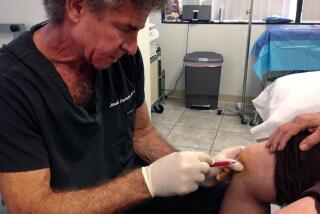Patents leave science pending
Dr. Philip H. Schwartz spent six years providing university researchers with neural stem cells cultured by a method he had helped invent at the Salk Institute in La Jolla.
He figured this was a win-win. His technique provided biomedical scientists with live tissue, an improvement over the dead cells, harvested from the brains of deceased patients, that had been the standard fare. Science marched ahead, bringing novel neurological applications closer to reality. The principles of wide dissemination of knowledge and scientific collaboration were served.
Then his employer, Children’s Hospital of Orange County, got a letter from Palo Alto-based StemCells Inc. The firm warned that Schwartz’s program infringed its patents in the neural stem cell field and it wished to, er, discuss a licensing arrangement.
The hospital’s lawyers advised Schwartz to stop sending out cells until they could make a deal with the company.
That was two years ago. There’s still no licensing deal, and there haven’t even been talks for more than a year.
“The long and the short of it,” Schwartz told me last week, “is that I’m dead in the water.”
On the surface, there shouldn’t be a huge obstacle to a deal between StemCells and CHOC.
Both say they’re open to an agreement. There isn’t much overlap among their core clienteles: The company “is not in the business of selling cells to researchers” in basic science, according to its general counsel, Ken Stratton. Conversely, CHOC’s Children’s Research Institute is interested in supporting only “academic noncommercial researchers,” says its director, Brent A. Dethlefs.
But in the biotech world, where millions or even billions of dollars in profits beckon to those who can assert ownership of important discoveries, good intentions and purely scientific goals don’t matter like they used to. Access by basic researchers to the essential building blocks of biomedical advances has been shrinking for years, thanks to a land rush by entrepreneurs wielding patent portfolios.
As the conflict between CHOC and StemCells suggests, the penetration of private investment concerns into what used to be largely academic pastures threatens to hobble, rather than hasten, the march of science. The harvest may be secrecy, delay and the directing of research only toward developments that promise quick financial returns.
In the stem cell field, “the pendulum may have swung too far” toward private enterprise and away from open research, says Gregory D. Graff, a patent expert at Colorado State University.
As it happens, StemCells has good reason to support the needs of academic researchers. For one thing, progress in fundamental stem cell research is likely to “improve the value of their [patent] portfolio,” Schwartz observes.
For another, the company’s founders include three leading academic stem cell scientists: Irving L. Weissman of Stanford University, David J. Anderson of Caltech and Fred Gage of Salk -- in whose very lab Schwartz developed his method.
None of the three appears to have gotten directly involved in the discussions, although one might think they would be especially sensitive to the need to balance the interests of private enterprise and academia. (None answered my requests for comment.)
So there has been no progress. The company says it did not explicitly threaten a lawsuit or even demand that CHOC cease distributing neural stem cells. But considering the firm’s access to litigation firepower -- it’s been waging a patent battle in court with another firm, Neuralstem Inc., since 2006 -- Dethlefs is probably wise to see its letter as a “veiled threat” and CHOC’s lawyers prudent in suspending Schwartz’s program.
Each side says it’s waiting for the other to make an offer, but things may be moving backward. On Jan. 23, Dethlefs sent out a memo explaining to researchers that because of the “unresolved legal issue,” it wouldn’t be distributing cell lines that might come under the StemCells patents for the foreseeable future. The memo was posted last month by John Simpson, a stem cell policy advocate, on his blog at consumerwatchdog.org.
The problem affects more than just biotech. This month, former Intel Corp. Chief Executive Andrew Grove told a Silicon Valley audience that the evolution of patents into investment assets controlled by speculators threatens to stifle innovation in many industries.
AT&T;’s decision to license the transistor for a nominal $25,000 fee after its invention at Bell Labs, Grove maintained, helped launch the electronics industry and led, eventually, to the invention of the microprocessor. Today, the transistor would be tied up in a web of patent claims and its license priced for short-term profits.
The corralling of scientific discoveries behind patent walls is connected to the trend of major universities viewing their own labs as potential profit centers.
This trend rose up to bite academia on the behind in 2002, when Duke University lost an important case in federal court. To fend off a claim that its physics lab infringed on a former professor’s patents, Duke asserted the “experimental use” exemption in patent law, which gave researchers doing purely academic work immunity from patent infringement claims.
But a federal appeals court found that Duke was, at heart, a business -- albeit one largely devoted to academic research. The judges pointed out that the university wasn’t shy about “pursuing an aggressive patent licensing program” of its own. They narrowed the experimental use exemption to a pinprick, applying it only to research done “solely for amusement, to satisfy idle curiosity, or for strictly philosophical inquiry.” The Supreme Court upheld the interpretation in 2003, jacking up the cost of basic research for everyone.
Navigating through patent thickets has become a permanent, and costly, part of any researcher’s existence, especially in the life sciences.
Graff says this phenomenon is becoming especially pronounced in stem cell science, which is especially dependent on collaboration but is already being cordoned off by commercial entities claiming property rights to essential research. The best solution, he says, may be for academic institutions -- where 45% of all stem cell research is performed -- to create collaborative patent pools so they can more freely disseminate information and technology without giving up all their potentially lucrative patent rights.
Until that happens, however, programs like CHOC’s will remain at the mercy of patent holders. Dethlefs says he believes that neural stem cells could be an important therapeutic tool and that Schwartz’s program fed directly into CHOC’s responsibility to serve its patients. Meanwhile, he says, “we’re considering our options,” which is the sort of thing you hear from people who don’t have many options.
--
Michael Hiltzik’s column appears Mondays and Thursdays.
Reach him at [email protected], read his previous columns at www.latimes.com/hiltzik, and follow @latimeshiltzik on Twitter.







